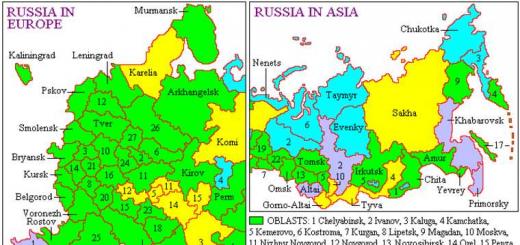Custom Search
Ozone and ozonation - clean air after a thunderstorm
Added: 2010-03-11
Ozone and ozonation - clean air after the Thunderstorm

We breathe 24 hours a day, 7 days a week, consuming about 25 kg of air daily. It turns out that we practically predetermine our health by the air we breathe.
And everyone knows that indoor air (and we are in them on average 60-90% of the time) is several times more polluted and toxic than atmospheric air.
And the more polluted it is, the more energy our body spends on neutralizing dangerous compounds and keeping the body in good shape. Is it any wonder in this case that we quickly become tired, lethargic, apathetic and irritable?
Ozone - what is it?
Back in 1785, physicist Martin Van Marum discovered that oxygen, under the influence of electric sparks, acquires a special “thunderstorm” smell and new chemical properties. Ozone is a special form of existence of oxygen, its modification. Translated from Greek, ozone means “smelling.”
Ozone- it is a blue gas with a characteristic odor, very strong oxidizing agent. The molecular formula of ozone is O3. It is heavier than oxygen and our usual air.
The scheme for the formation of ozone is as follows: under the influence of an electric discharge, part of the oxygen molecules O2 disintegrates into atoms, then atomic oxygen combines with molecular oxygen and ozone O3 is formed. In nature, ozone is formed in the stratosphere under the influence of ultraviolet radiation from the Sun, as well as during electrical discharges in the atmosphere.
During a thunderstorm, when electrical discharges of lightning “pierce” the atmosphere, we feel the resulting ozone as fresh air. This is especially noticeable in places rich in oxygen: in a forest, in a coastal area or near a waterfall. Ozone really cleans our air! Being a strong oxidizing agent, it decomposes many toxic impurities in the atmosphere into simple safe compounds, thereby disinfecting the air. That’s why after a thunderstorm we feel pleasantly fresh, we can breathe easily, and we see everything around us more clearly, especially the blue of the sky.
The bulk of ozone in the atmosphere is located at an altitude of 10 to 50 km with a maximum concentration at an altitude of 20-25 km, forming a layer called the ozonosphere.
The ozonosphere reflects hard ultraviolet radiation and protects living organisms from the harmful effects of radiation. It was thanks to the formation of ozone from atmospheric oxygen that life on land became possible.
However, we know that ozone is an oxidizing agent. Isn't it harmful to humans and all living things? Any substance can be both poison and medicine - it all depends on the dose. Low concentrations of ozone create a feeling of freshness, disinfect the environment around us, and “cleanse” our respiratory tract. But high concentrations of ozone can cause irritation of the respiratory tract, coughing, and dizziness.
Therefore, relatively high concentrations of ozone are used to disinfect water and air, while lower concentrations promote wound healing and are widely used in cosmetology.
Household ozonation devices provide a safe concentration of ozone for humans.
With the help of an ozonizer you will always breathe fresh and clean air!
Where is ozone used today?
Ozone is widely used in various areas of our lives. It is used in medicine, in industry, and in everyday life.
The most common application is for water purification. Ozone effectively destroys bacteria and viruses, eliminates many harmful impurities, including cyanides, phenols, organic water contaminants, destroys odors, and can be used as a bleaching reagent.
Ozone is widely used in the chemical industry.
Ozone plays a special role in the food industry. A highly disinfectant and chemically safe agent, it is used to prevent the biological growth of unwanted organisms in food and food processing equipment. Ozone has the ability to kill microorganisms without creating new harmful chemicals.
Ozone contributes to the long-term preservation of the quality of meat, fish, eggs, and cheeses. In the process of ozonation, microbes and bacteria, harmful chemicals, viruses, mold are destroyed, and the nitrate content in vegetables and fruits is significantly reduced.
Ozone is successfully used in medicine. As a strong oxidizing agent, it is used to sterilize medical products. The scope of its use in the treatment of many diseases is expanding.
Ozone is highly effective in destroying bacteria, fungi and protozoa. Ozone has a quick and radical effect on many viruses, while (unlike many antiseptics) it does not have a destructive or irritating effect on tissue, since the cells of a multicellular organism have an antioxidant defense system.
Air ozonation promotes the destruction of chemicals hazardous to health (formaldehyde, phenol, styrene from varnishes, paints, furniture, especially chipboard), tobacco smoke, organic substances (sources - insects, pets, rodents), detergents and cleaners, combustion products and burnt materials , mold, fungi and bacteria.
All chemicals that are in the air, reacting with ozone, break down into harmless compounds: carbon dioxide, water and oxygen.
Bactericidal effect
- Ozone kills harmful microbes in the air by 99.9%.
- Ozone kills E. coli 100%; 95.5% copes with staphylococcus and 99.9% eliminates golden and white staphylococci.
- Ozone also very quickly and 100% kills E. coli and Staphylococcus aureus in the water.
- Studies have shown that after 15 minutes of treating the air with ozone, the harmful microorganisms in it completely die.
- Ozone is 100% effective against the hepatitis virus and PVI virus, and 99% effective against the influenza virus.
- Ozone 100% destroys various types of mold.
- Ozone dissolved in water is 100% effective against black mold and yeast.
Household ozonizer GRAZA

For what purposes is a household ozonizer used?
1. Air purification in residential premises, bathrooms and toilets;
2. Elimination of unpleasant odors in the refrigerator, wardrobes, pantries, etc.;
3. Purification of drinking water, ozonation of baths, aquariums; 4. Food processing (vegetables, fruits, eggs, meat, fish);
5. Disinfection and elimination of dirt and unpleasant odors when washing clothes;
6. Cosmetology procedures, care for the oral cavity, facial skin, hands and feet;
7. Elimination of the smell of tobacco smoke, paint, varnish.
Specifications
Ozone productivity: 300 mg/h. Power, no more: 30 W. Maximum operating time without interruption: no more than 30 minutes. Pause time when the device is operating for more than 30 minutes: at least 10 minutes. Discretion of operating time settings: 1 minute. Mains power: 220V, 50 Hz. Overall dimensions: 185*130*55 mm. Weight: 0.6 kg.
The impact of the ozonizer extends to a depth of 10 cm.
Ozone concentration 300 mg/hour.
Completeness:
1. Household ozonizer “Thunderstorm” 1 pc.
2. Nozzle (diffuse stone) 3 pcs.
3. Silicone tube 100 cm. 1 pc.
4. Silicone tube 120 cm. 1 pc.
5. Passport 1 pc.
6. Application brochure 1 pc.
Warranty period of the device– 12 months from the date of sale, but not more than 18 months from the date of manufacture. Service life – 8 years.
Complies with TU 3468-015-20907995-2009. Has a certificate of conformity No. POCC RU. AE 88. B00073.
The device consists of: a control unit, a high voltage generator, an ozone generator, and a compressor.
The physical properties of ozone are very characteristic: it is an easily explosive gas of blue color. A liter of ozone weighs approximately 2 grams, and air - 1.3 grams. Therefore, ozone is heavier than air. The melting point of ozone is minus 192.7ºС. This “melted” ozone is a dark blue liquid. Ozone “ice” has a dark blue color with a violet tint and becomes opaque when its thickness exceeds 1 mm. The boiling point of ozone is minus 112ºС. In the gaseous state, ozone is diamagnetic, i.e. does not have magnetic properties, and in the liquid state it is weakly paramagnetic. The solubility of ozone in melt water is 15 times greater than that of oxygen and is approximately 1.1 g/l. 2.5 grams of ozone dissolves in a liter of acetic acid at room temperature. It also dissolves well in essential oils, turpentine, and carbon tetrachloride. The odor of ozone is felt at concentrations above 15 µg/m3 of air. In minimal concentrations it is perceived as a “smell of freshness”; in higher concentrations it acquires a sharp, irritating hue.
Ozone is formed from oxygen according to the following formula: 3O2 + 68 kcal → 2O3. Classic examples of ozone formation: under the influence of lightning during a thunderstorm; under the influence of sunlight in the upper atmosphere. Ozone can also be formed during any processes accompanied by the release of atomic oxygen, for example, during the decomposition of hydrogen peroxide. Industrial ozone synthesis involves the use of electrical discharges at low temperatures. Technologies for producing ozone may differ from each other. Thus, to produce ozone used for medical purposes, only pure (without impurities) medical oxygen is used. Separation of the resulting ozone from oxygen impurities is usually not difficult due to differences in physical properties (ozone liquefies more easily). If certain qualitative and quantitative reaction parameters are not required, then obtaining ozone does not present any particular difficulties.
The O3 molecule is unstable and quite quickly turns into O2 with the release of heat. At small concentrations and without foreign impurities, ozone decomposes slowly, at large concentrations it decomposes explosively. Alcohol immediately ignites on contact with it. Heating and contact of ozone even with insignificant amounts of the oxidation substrate (organic substances, some metals or their oxides) sharply accelerates its decomposition. Ozone can be stored for a long time at − 78ºС in the presence of a stabilizer (a small amount of HNO3), as well as in vessels made of glass, some plastics or noble metals.
Ozone is the strongest oxidizing agent. The reason for this phenomenon lies in the fact that atomic oxygen is formed during the decay process. Such oxygen is much more aggressive than molecular oxygen, because in the oxygen molecule the deficiency of electrons at the external level due to their collective use of the molecular orbital is not so noticeable.
Back in the 18th century, it was noticed that mercury in the presence of ozone loses its shine and sticks to the glass, i.e. oxidizes. And when ozone is passed through an aqueous solution of potassium iodide, iodine gas begins to be released. The same “tricks” did not work with pure oxygen. Subsequently, the properties of ozone were discovered, which were immediately adopted by mankind: ozone turned out to be an excellent antiseptic, ozone quickly removed organic substances of any origin (perfumes and cosmetics, biological fluids) from water, began to be widely used in industry and everyday life, and has proven itself in as an alternative to a dental drill.
In the 21st century, the use of ozone in all areas of human life and activity is growing and developing, and therefore we are witnessing its transformation from exotic into a familiar tool for everyday work. OZONE O3, allotropic form of oxygen.
Preparation and physical properties of ozone.
Scientists first learned about the existence of an unknown gas when they began experimenting with electrostatic machines. This happened in the 17th century. But they began to study the new gas only at the end of the next century. In 1785, Dutch physicist Martin van Marum obtained ozone by passing electric sparks through oxygen. The name ozone appeared only in 1840; it was invented by the Swiss chemist Christian Schönbein, deriving it from the Greek ozon - smelling. The chemical composition of this gas did not differ from oxygen, but it was much more aggressive. Thus, it instantly oxidized colorless potassium iodide, releasing brown iodine; Schönbein used this reaction to determine ozone by the degree of blueness of paper soaked in a solution of potassium iodide and starch. Even mercury and silver, which are inactive at room temperature, are oxidized in the presence of ozone.
It turned out that ozone molecules, like oxygen, consist only of oxygen atoms, but not two, but three. Oxygen O2 and ozone O3 are the only example of the formation of two gaseous (under normal conditions) simple substances by one chemical element. In the O3 molecule, the atoms are located at an angle, so these molecules are polar. Ozone is obtained as a result of the “sticking” of free oxygen atoms to O2 molecules, which are formed from oxygen molecules under the influence of electrical discharges, ultraviolet rays, gamma rays, fast electrons and other high-energy particles. There is always a smell of ozone near operating electric machines, in which brushes “spark,” and near bactericidal mercury-quartz lamps that emit ultraviolet light. Oxygen atoms are also released during certain chemical reactions. Ozone is formed in small quantities during the electrolysis of acidified water, during the slow oxidation of wet white phosphorus in air, during the decomposition of compounds with a high oxygen content (KMnO4, K2Cr2O7, etc.), during the action of fluorine on water or concentrated sulfuric acid on barium peroxide. Oxygen atoms are always present in the flame, so if you direct a stream of compressed air across the flame of an oxygen burner, the characteristic smell of ozone will be detected in the air.
The reaction 3O2 → 2O3 is highly endothermic: to obtain 1 mole of ozone, 142 kJ must be consumed. The reverse reaction occurs with the release of energy and is carried out very easily. Accordingly, ozone is unstable. In the absence of impurities, ozone gas decomposes slowly at a temperature of 70° C and quickly above 100° C. The rate of ozone decomposition increases significantly in the presence of catalysts. They can be gases (for example, nitric oxide, chlorine), and many solids (even the walls of a vessel). Therefore, pure ozone is difficult to obtain, and working with it is dangerous due to the possibility of explosion.
It is not surprising that for many decades after the discovery of ozone, even its basic physical constants were unknown: for a long time no one was able to obtain pure ozone. As D.I. Mendeleev wrote in his textbook Fundamentals of Chemistry, “with all methods of preparing ozone gas, its content in oxygen is always insignificant, usually only a few tenths of a percent, rarely 2%, and only at very low temperatures does it reach 20%.” Only in 1880 did the French scientists J. Gotfeil and P. Chappuis obtain ozone from pure oxygen at a temperature of minus 23 ° C. It turned out that in a thick layer ozone has a beautiful blue color. When the cooled ozonated oxygen was slowly compressed, the gas turned dark blue, and after quickly releasing the pressure, the temperature dropped even further and dark purple droplets of liquid ozone formed. If the gas was not cooled or compressed quickly, then the ozone instantly, with a yellow flash, turned into oxygen.
Later, a convenient method for ozone synthesis was developed. If a concentrated solution of perchloric, phosphoric or sulfuric acid is subjected to electrolysis with a cooled platinum or lead(IV) oxide anode, the gas released at the anode will contain up to 50% ozone. The physical constants of ozone were also refined. It liquefies much easier than oxygen - at a temperature of -112° C (oxygen - at -183° C). At -192.7° C ozone solidifies. Solid ozone is blue-black in color.
Experiments with ozone are dangerous. Ozone gas can explode if its concentration in the air exceeds 9%. Liquid and solid ozone explode even more easily, especially when in contact with oxidizing substances. Ozone can be stored at low temperatures in the form of solutions in fluorinated hydrocarbons (freons). Such solutions are blue in color.
Chemical properties of ozone.
Ozone is characterized by extremely high reactivity. Ozone is one of the strongest oxidizing agents and is second in this regard only to fluorine and oxygen fluoride OF2. The active principle of ozone as an oxidizing agent is atomic oxygen, which is formed during the decay of the ozone molecule. Therefore, acting as an oxidizing agent, the ozone molecule, as a rule, “uses” only one oxygen atom, and the other two are released in the form of free oxygen, for example, 2KI + O3 + H2O → I2 + 2KOH + O2. The oxidation of many other compounds also occurs. However, there are exceptions when the ozone molecule uses all three oxygen atoms it has for oxidation, for example, 3SO2 + O3 → 3SO3; Na2S + O3 → Na2SO3.
A very important difference between ozone and oxygen is that ozone exhibits oxidizing properties already at room temperature. For example, PbS and Pb(OH)2 do not react with oxygen under normal conditions, while in the presence of ozone the sulfide is converted into PbSO4, and the hydroxide into PbO2. If a concentrated ammonia solution is poured into a vessel with ozone, white smoke will appear - this is ozone oxidizing ammonia to form ammonium nitrite NH4NO2. Particularly characteristic of ozone is the ability to “blacken” silver items with the formation of AgO and Ag2O3.
By adding one electron and becoming a negative ion O3-, the ozone molecule becomes more stable. “Ozone acid salts” or ozonides containing such anions have been known for a long time - they are formed by all alkali metals except lithium, and the stability of ozonides increases from sodium to cesium. Some ozonides of alkaline earth metals are also known, for example, Ca(O3)2. If a stream of ozone gas is directed onto the surface of a solid dry alkali, an orange-red crust containing ozonides is formed, for example, 4KOH + 4O3 → 4KO3 + O2 + 2H2O. At the same time, solid alkali effectively binds water, which protects ozonide from immediate hydrolysis. However, with an excess of water, ozonides rapidly decompose: 4KO3+ 2H2O → 4KOH + 5O2. Decomposition also occurs during storage: 2KO3 → 2KO2 + O2. Ozonides are highly soluble in liquid ammonia, which made it possible to isolate them in their pure form and study their properties.
Organic substances with which ozone comes into contact are usually destroyed. Thus, ozone, unlike chlorine, is capable of splitting the benzene ring. When working with ozone, you cannot use rubber tubes and hoses - they will instantly become leaky. Reactions of ozone with organic compounds release large amounts of energy. For example, ether, alcohol, cotton wool soaked in turpentine, methane and many other substances spontaneously ignite when in contact with ozonated air, and mixing ozone with ethylene leads to a strong explosion.
Application of ozone.
Ozone does not always “burn” organic matter; in some cases it is possible to carry out specific reactions with highly dilute ozone. For example, when oleic acid is ozonated (it is found in large quantities in vegetable oils), azelaic acid HOOC(CH2)7COOH is formed, which is used to produce high-quality lubricating oils, synthetic fibers and plasticizers for plastics. Adipic acid is obtained similarly, which is used in the synthesis of nylon. In 1855, Schönbein discovered the reaction of unsaturated compounds containing double C=C bonds with ozone, but only in 1925 did the German chemist H. Staudinger establish the mechanism of this reaction. An ozone molecule attaches to a double bond to form an ozonide - this time organic, and an oxygen atom replaces one of the C=C bonds, and an -O-O- group takes the place of the other. Although some organic ozonides are isolated in pure form (for example, ethylene ozonide), this reaction is usually carried out in a dilute solution, since free ozonides are very unstable explosives. The ozonation reaction of unsaturated compounds is held in high esteem by organic chemists; Problems with this reaction are often offered even at school competitions. The fact is that when ozonide decomposes with water, two aldehyde or ketone molecules are formed, which are easy to identify and further establish the structure of the original unsaturated compound. Thus, chemists at the beginning of the 20th century established the structure of many important organic compounds, including natural ones, containing C=C bonds.
An important area of application of ozone is the disinfection of drinking water. Usually water is chlorinated. However, some impurities in water under the influence of chlorine turn into compounds with a very unpleasant odor. Therefore, it has long been proposed to replace chlorine with ozone. Ozonated water does not acquire any foreign smell or taste; When many organic compounds are completely oxidized by ozone, only carbon dioxide and water are formed. Ozone also purifies wastewater. Ozone oxidation products of even such pollutants as phenols, cyanides, surfactants, sulfites, chloramines are harmless, colorless and odorless compounds. Excess ozone disintegrates quite quickly to form oxygen. However, water ozonation is more expensive than chlorination; In addition, ozone cannot be transported and must be produced at the point of use.
Ozone in the atmosphere.
There is little ozone in the Earth's atmosphere - 4 billion tons, i.e. on average only 1 mg/m3. The concentration of ozone increases with distance from the Earth's surface and reaches a maximum in the stratosphere, at an altitude of 20-25 km - this is the “ozone layer”. If all the ozone from the atmosphere were collected at the Earth's surface at normal pressure, the resulting layer would be only about 2-3 mm thick. And such small amounts of ozone in the air actually support life on Earth. Ozone creates a “protective screen” that prevents hard ultraviolet rays from the sun, which are destructive to all living things, from reaching the Earth’s surface.
In recent decades, much attention has been paid to the appearance of so-called “ozone holes” - areas with significantly reduced levels of stratospheric ozone. Through such a “leaky” shield, harsher ultraviolet radiation from the Sun reaches the Earth’s surface. That's why scientists have been monitoring ozone in the atmosphere for a long time. In 1930, the English geophysicist S. Chapman, to explain the constant concentration of ozone in the stratosphere, proposed a scheme of four reactions (these reactions were called the Chapman cycle, in which M means any atom or molecule that carries away excess energy):
O + O + M → O2 + M
O + O3 → 2O2
O3 → O2 + O.
The first and fourth reactions of this cycle are photochemical, they occur under the influence of solar radiation. To decompose an oxygen molecule into atoms, radiation with a wavelength of less than 242 nm is required, while ozone disintegrates when light is absorbed in the region of 240-320 nm (the latter reaction precisely protects us from hard ultraviolet radiation, since oxygen does not absorb in this spectral region) . The remaining two reactions are thermal, i.e. go without the influence of light. It is very important that the third reaction, leading to the disappearance of ozone, has an activation energy; this means that the rate of such a reaction can be increased by the action of catalysts. As it turned out, the main catalyst for ozone decomposition is nitric oxide NO. It is formed in the upper layers of the atmosphere from nitrogen and oxygen under the influence of the harshest solar radiation. Once in the ozonosphere, it enters a cycle of two reactions O3 + NO → NO2 + O2, NO2 + O → NO + O2, as a result of which its content in the atmosphere does not change, and the stationary ozone concentration decreases. There are other cycles that lead to a decrease in ozone content in the stratosphere, for example, with the participation of chlorine:
Cl + O3 → ClO + O2
ClO + O → Cl + O2.
Ozone is also destroyed by dust and gases that enter the atmosphere in large quantities during volcanic eruptions. Recently, it has been suggested that ozone is also effective in destroying hydrogen released from the earth's crust. The combination of all reactions of ozone formation and decay leads to the fact that the average lifetime of an ozone molecule in the stratosphere is about three hours.
It is believed that in addition to natural, there are also artificial factors that affect the ozone layer. A well-known example is freons, which are sources of chlorine atoms. Freons are hydrocarbons in which hydrogen atoms are replaced by fluorine and chlorine atoms. They are used in refrigeration technology and for filling aerosol cans. Ultimately, freons enter the air and slowly rise higher and higher with air currents, finally reaching the ozone layer. Decomposing under the influence of solar radiation, freons themselves begin to catalytically decompose ozone. It is not yet known exactly to what extent freons are to blame for the “ozone hole,” and, nevertheless, measures have long been taken to limit their use.
Calculations show that in 60-70 years, the ozone concentration in the stratosphere may decrease by 25%. And at the same time, the concentration of ozone in the ground layer - the troposphere - will increase, which is also bad, since ozone and the products of its transformations in the air are poisonous. The main source of ozone in the troposphere is the transfer of stratospheric ozone with air masses to the lower layers. Every year, approximately 1.6 billion tons of ozone enter the ground layer. The lifetime of an ozone molecule in the lower part of the atmosphere is much longer - more than 100 days, since the intensity of ultraviolet solar radiation that destroys ozone is lower in the ground layer. Usually there is very little ozone in the troposphere: in clean fresh air its concentration averages only 0.016 μg/l. The concentration of ozone in the air depends not only on altitude, but also on terrain. Thus, there is always more ozone over the oceans than over land, since ozone decays more slowly there. Measurements in Sochi showed that the air near the sea coast contains 20% more ozone than in a forest 2 km from the coast.
Modern people inhale significantly more ozone than their ancestors. The main reason for this is the increase in the amount of methane and nitrogen oxides in the air. Thus, the content of methane in the atmosphere has been constantly increasing since the mid-19th century, when the use of natural gas began. In an atmosphere polluted with nitrogen oxides, methane enters into a complex chain of transformations with the participation of oxygen and water vapor, the result of which can be expressed by the equation CH4 + 4O2 → HCHO + H2O + 2O3. Other hydrocarbons can also act as methane, for example, those contained in car exhaust gases during incomplete combustion of gasoline. As a result, the concentration of ozone in the air of large cities has increased tenfold over the past decades.
It has always been believed that during a thunderstorm, the concentration of ozone in the air increases sharply, since lightning promotes the conversion of oxygen into ozone. In fact, the increase is insignificant, and it does not occur during a thunderstorm, but several hours before it. During a thunderstorm and for several hours after it, the ozone concentration decreases. This is explained by the fact that before a thunderstorm there is a strong vertical mixing of air masses, so that an additional amount of ozone comes from the upper layers. In addition, before a thunderstorm, the electric field strength increases, and conditions are created for the formation of a corona discharge at the tips of various objects, for example, the tips of branches. This also contributes to the formation of ozone. And then, as a thundercloud develops, powerful upward air currents arise beneath it, which reduce the ozone content directly below the cloud.
An interesting question is about the ozone content in the air of coniferous forests. For example, in the Course of Inorganic Chemistry by G. Remy, you can read that “ozonized air of coniferous forests” is a fiction. Is it so? Of course, no plant produces ozone. But plants, especially conifers, emit many volatile organic compounds into the air, including unsaturated hydrocarbons of the terpene class (there are many of them in turpentine). So, on a hot day, pine releases 16 micrograms of terpenes per hour for every gram of dry weight of needles. Terpenes are released not only by conifers, but also by some deciduous trees, including poplar and eucalyptus. And some tropical trees are capable of releasing 45 mcg of terpenes per 1 g of dry mass of leaves per hour. As a result, one hectare of coniferous forest can release up to 4 kg of organic matter per day, and about 2 kg of deciduous forest. The forested area of the Earth is millions of hectares, and all of them emit hundreds of thousands of tons of various hydrocarbons, including terpenes, per year. And hydrocarbons, as was shown with the example of methane, under the influence of solar radiation and in the presence of other impurities contribute to the formation of ozone. As experiments have shown, terpenes, under suitable conditions, are indeed very actively involved in the cycle of atmospheric photochemical reactions with the formation of ozone. So ozone in a coniferous forest is not a fiction at all, but an experimental fact.
Ozone and health.
How nice it is to take a walk after a thunderstorm! The air is clean and fresh, its invigorating streams seem to flow into the lungs without any effort. “It smells like ozone,” they often say in such cases. “Very good for health.” Is it so?
At one time, ozone was certainly considered beneficial to health. But if its concentration exceeds a certain threshold, it can cause a lot of unpleasant consequences. Depending on the concentration and time of inhalation, ozone causes changes in the lungs, irritation of the mucous membranes of the eyes and nose, headache, dizziness, and decreased blood pressure; Ozone reduces the body's resistance to bacterial respiratory tract infections. The maximum permissible concentration in the air is only 0.1 μg/l, which means that ozone is much more dangerous than chlorine! If you spend several hours in a room with an ozone concentration of only 0.4 μg/l, chest pain, cough, insomnia may appear, and visual acuity may decrease. If you breathe ozone for a long time at a concentration of more than 2 μg/l, the consequences can be more severe - even torpor and decline in cardiac activity. When the ozone content is 8-9 µg/l, pulmonary edema occurs within a few hours, which can be fatal. But such tiny amounts of a substance are usually difficult to analyze using conventional chemical methods. Fortunately, a person feels the presence of ozone even at very low concentrations - about 1 μg/l, at which starch iodine paper is not yet going to turn blue. To some people, the smell of ozone in low concentrations resembles the smell of chlorine, to others - to sulfur dioxide, to others - to garlic.
It's not just ozone itself that is toxic. With its participation in the air, for example, peroxyacetyl nitrate (PAN) CH3-CO-OONO2 is formed - a substance that has a strong irritant, including tear-producing, effect, making breathing difficult, and in higher concentrations causing cardiac paralysis. PAN is one of the components of the so-called photochemical smog formed in summer in polluted air (this word is derived from the English smoke - smoke and fog - fog). The ozone concentration in smog can reach 2 µg/l, which is 20 times more than the maximum permissible limit. It should also be taken into account that the combined effect of ozone and nitrogen oxides in the air is tens of times stronger than each substance separately. It is not surprising that the consequences of such smog in large cities can be catastrophic, especially if the air above the city is not blown through by “drafts” and a stagnant zone is formed. Thus, in London in 1952, more than 4,000 people died from smog within a few days. And smog in New York in 1963 killed 350 people. There were similar stories in Tokyo and other large cities. It's not just people who suffer from atmospheric ozone. American researchers have shown, for example, that in areas with high levels of ozone in the air, the service life of car tires and other rubber products is significantly reduced.
How to reduce the ozone content in the ground layer? It is hardly realistic to reduce the release of methane into the atmosphere. There remains another way - to reduce emissions of nitrogen oxides, without which the cycle of reactions leading to ozone cannot proceed. This path is also not easy, since nitrogen oxides are emitted not only by cars, but also (mainly) by thermal power plants.
Sources of ozone are not only on the street. It is formed in X-ray rooms, in physiotherapy rooms (its source is mercury-quartz lamps), during the operation of copying equipment (copiers), laser printers (here the reason for its formation is a high-voltage discharge). Ozone is an inevitable companion to the production of perhydrol and argon arc welding. To reduce the harmful effects of ozone, it is necessary to have ventilation equipment near ultraviolet lamps and good ventilation of the room.
And yet it is hardly correct to consider ozone as undoubtedly harmful to health. It all depends on its concentration. Studies have shown that fresh air glows very faintly in the dark; The reason for the glow is oxidation reactions involving ozone. The glow was also observed when shaking water in a flask into which ozonized oxygen had previously been introduced. This glow is always associated with the presence of small amounts of organic impurities in the air or water. When fresh air was mixed with a person’s exhaled breath, the intensity of the glow increased tenfold! And this is not surprising: microimpurities of ethylene, benzene, acetaldehyde, formaldehyde, acetone, and formic acid were found in the exhaled air. They are “highlighted” by ozone. At the same time, “stale”, i.e. completely devoid of ozone, although very clean, the air does not produce a glow, and a person perceives it as “musty.” Such air can be compared to distilled water: it is very clean, practically free of impurities, and drinking it is harmful. So the complete absence of ozone in the air, apparently, is also unfavorable for humans, since it increases the content of microorganisms in it and leads to the accumulation of harmful substances and unpleasant odors, which ozone destroys. Thus, the need for regular and long-term ventilation of rooms becomes clear, even if there are no people in it: after all, ozone that enters a room does not stay in it for a long time - it partially disintegrates, and largely settles (adsorbs) on the walls and other surfaces. It is difficult to say how much ozone there should be in the room. However, in minimal concentrations, ozone is probably necessary and beneficial.
Thus, ozone is a time bomb. If it is used correctly, it will serve humanity, but as soon as it is used for other purposes, it will instantly lead to a global catastrophe and the Earth will turn into a planet like Mars.
We all notice every time that after a thunderstorm the air smells pleasantly fresh. Why does this happen? The fact is that after a thunderstorm, a large amount of a special gas appears in the air - ozone. It is ozone that has such a delicate, pleasant smell of freshness. Many companies involved in the production of household chemicals are trying to create products with the smell of rain, but no one has yet succeeded. Everyone's perception of fresh air is different. So, the mechanism for the appearance of ozone in the air after a thunderstorm:
- there are a large number of molecules of various gases in the air;
- many gas molecules contain oxygen;
- As a result of the impact of a powerful electric charge of lightning on gas molecules, ozone appears in the air - a gas whose formula is represented by a molecule consisting of three oxygen atoms.
Reasons why air remains fresh for a short time after a thunderstorm
In general, unfortunately, this freshness does not last long. Much depends on how strong and long the duration of the thunderstorm was. We all know that the pleasant freshness of the post-storm air disappears after a while. This is due to the process of diffusion. The science of physics, and, to some extent, chemistry, studies this process. In simple words, diffusion means the process of mixing substances, the mutual penetration of atoms of one substance into another. As a result of the diffusion process, atoms of substances are mutually evenly distributed in a certain space, in a given volume. The ozone molecule consists of three oxygen atoms. As they move, molecules of different gases collide and exchange atoms. As a result, molecules of oxygen, carbon dioxide, nitrogen and many other gases reappear.
- in the process of diffusion, gas molecules collide and exchange atoms;
- many different gases arise: nitrogen, oxygen, carbon dioxide and others;
- The ozone concentration in the area where the thunderstorm occurred gradually decreases due to the uniform distribution of the available amount of gas in the atmosphere.
It is the process of diffusion that leads to this natural phenomenon.










